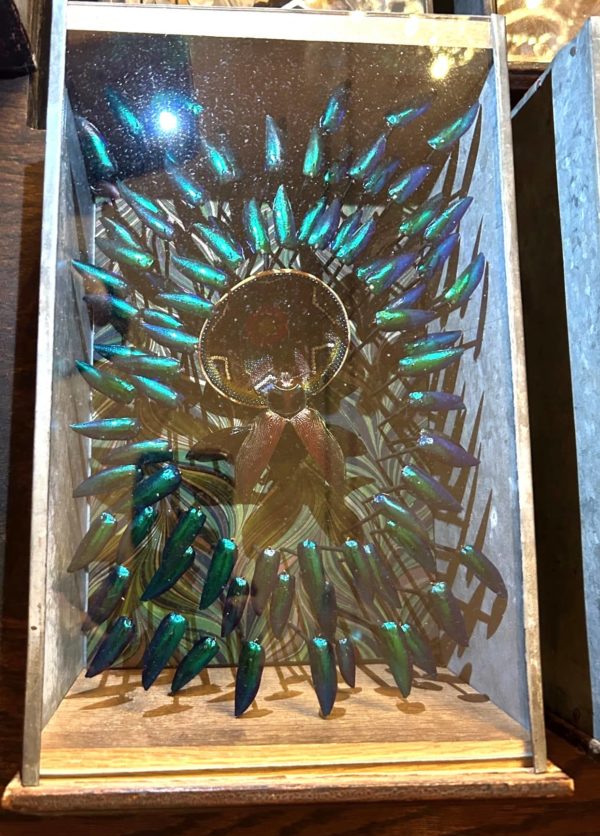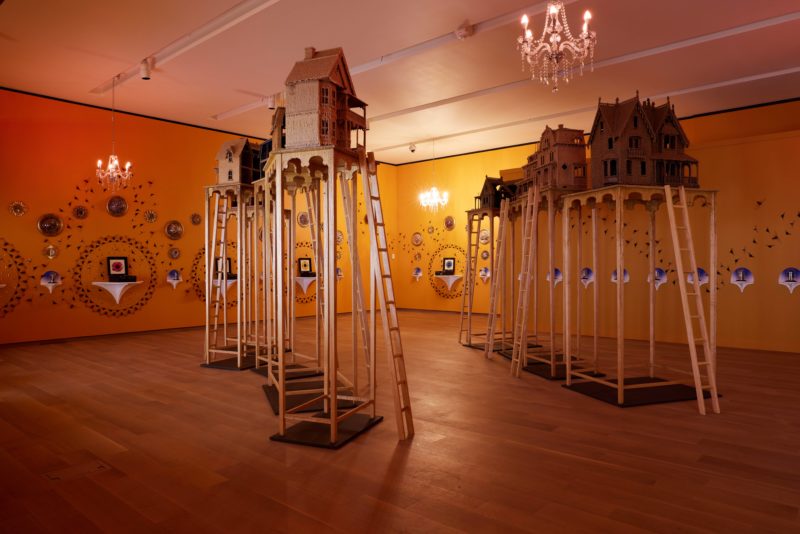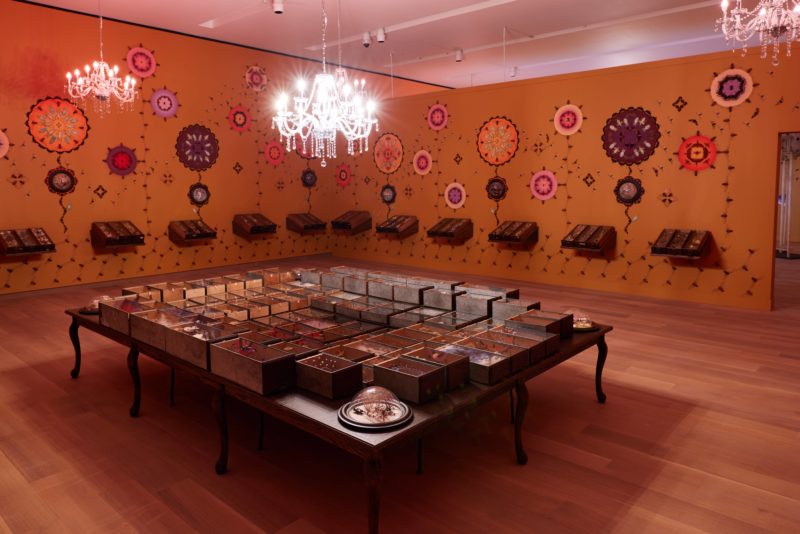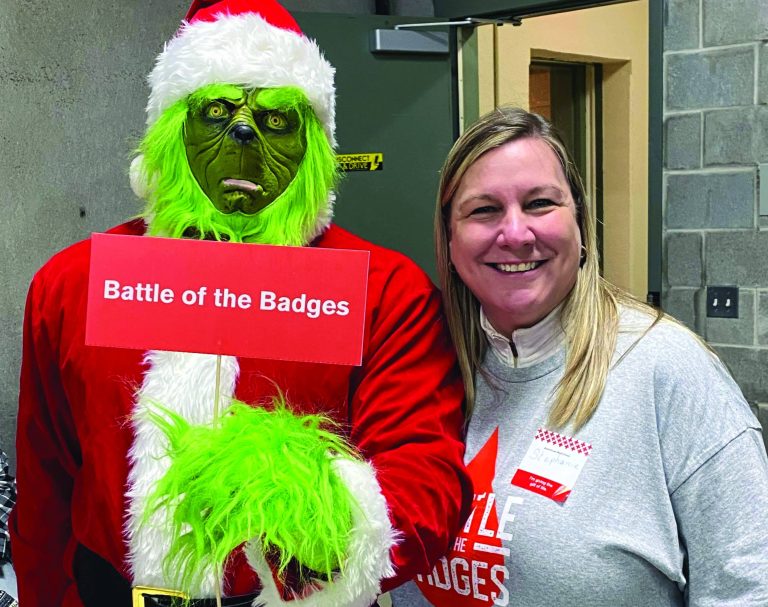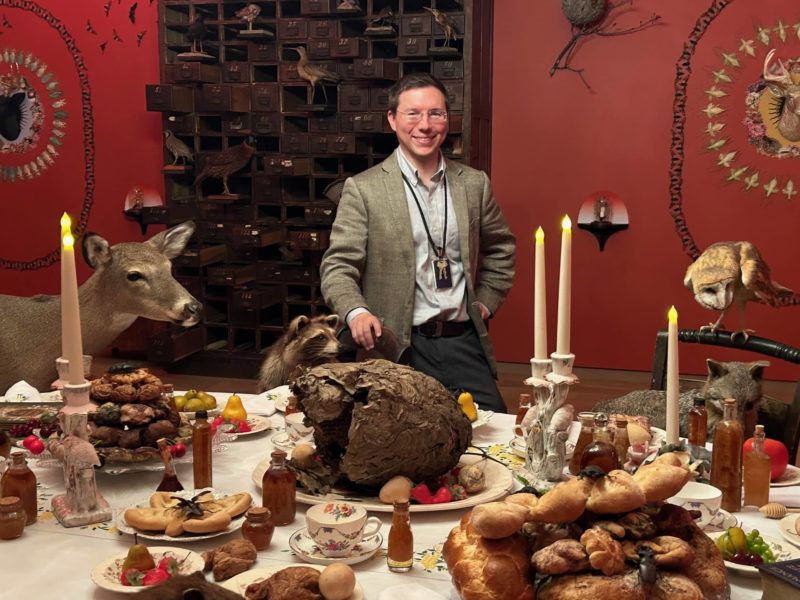
By Anne W. Semmes
For over 20 years Jennifer Angus of Madison, Wisconsin, an artist in the field of textiles, has extended her art with exhibits displaying insects on wallpaper and placing them in artfully crafted vignettes for an innovative mix of art and science. When Dr. Ksepka happened upon her exhibit of this extraordinary mix some years ago in the Renwick Gallery of the Smithsonian American Art Museum in Washington, D.C. he was immediately drawn to it. So, now happily with the newly enlarged Bruce three rooms are able to display Angus’ ambitious pairing of insects in artistic and descriptive settings.
Angus’ title for her insect art exhibit “The Golden Hour” spells out the raison d’etre for her exhibit at “a time on earth where so many species are disappearing.” Thus, on display are close to 5,000 insects beautifully displayed – and celebrated – on wallpaper and placed story-like within several hundred vignettes. Shining elegantly over the dusky interiors are crystal chandeliers.
With Ksepka as guide we entered the first room entitled, “The Village.” Set high up on stilts were doll houses. “Just like Alice in Wonderland you become almost insect sized,” Angus has written. And those houses were “actually crusted with beeswax,” said Ksepka who discovered that “wonderful” smell when they were set up. “So obviously that’s an insect reference, but you’re walking down the street towards the church.” And seen on the wall of that village as if in a church were stained glass windows – lit up jelly jars preserving damaged and deceased insects. And written on each jar by Angus was the date each species was preserved.
We then entered the second room called “Cabinet of Curiosities” that featured multitudinous boxed vignettes under glass. Each vignette told a story featuring a particular insect. “We encourage guests to use their little [iPhone] flashlights,” said Ksepka, having lit up his iPhone to shine into those vignettes. Speaking of light Ksepka commented on how this room was getting darker, closer to that “golden hour.”
Ksepka pointed up to the insect-decorated wall that he called “the real tour de force. So, every one of these insects had to be pinned on. And each one needs the four little hammer taps. And so probably 32,000 swings of the hammer needed to get these all up.” And “These are a lot of cicadas, a leaf insect.” And a giant insect featured was the Thorny Stick. “And that’s the female. And the male is much smaller.”
But back to those cicadas. These were not those cicadas “that stay underground for 13 or 17 years, and then they emerge en masse. These are what we’d call annual cicadas, where they don’t have that long underground life span.” And don’t look for butterflies and moths, “because they fall apart easily. Cicadas are more sturdy.” Also seen were those “really cool grasshoppers with their beautiful pink wings.” And the many beetles displayed were chosen “because they’re abundant, so we don’t have to worry about collecting them…They hold up well, and because they’re beautiful.”
Surprisingly, with all the pinning of Angus’ insects, “She’s used a lot of these insects for 20 or more years,” Ksepka told, “So, when we take these down, each one gets pinned back onto its special board and taken to the next show. This is her treasure trove of insects – they’ll be reused over and over. And if one of them gets damaged, there’s a little hospital, so they can be repaired to a certain extent.”
Beetles were everywhere to be seen, especially the iridescent gold beetles and green beetles. Ksepka told of there being 100’s of 1000’s of beetle species. And those iridescent beetles often get made into earrings or necklaces or on dresses. In fact, noted Ksepka, it was when Angus as textile artist had come across a dress made with green beetle wings, that she was led to insect art. “So, one of these vignettes has a whole bunch of these green beetle wings.”
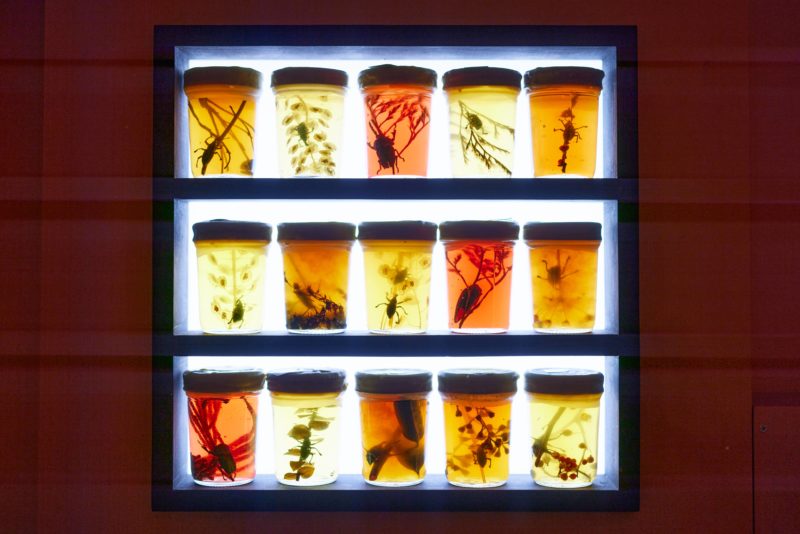
And just where do these thousands of insects on display come from? “So, most of these come from insect farms and dealers all over the world,” told Ksepka. “Jennifer buys them. They’re all species that are hyper abundant. You wouldn’t collect anything that’s rare. There are insects from five continents here.” And those gold beetles at $100 a pop come from Costa Rica? “Yes,” he said.
Stepping into the third “Dining Room,” was another revelation, and there Curator Ksepka played a critical part. Seated around a dining table were animal specimens Ksepka provided from the Bruce collection. “Basically, “I’m running back and forth for supplies, because Jennifer installs it all herself. She had an assistant with her, but she creates all this in her mind, then maps it out on a computer, then physically puts it together.” He loves the “density of the show…a show that you can come back to again and again.”
Against the wall a tall wooden cabinet with drawers featured numerous birds. Atop it was a fox with a grouse in his mouth. “Most of these are game birds,” said Ksepka whose field is birds. He joked, “This is what you’d see if you opened up my brain, because I work on bird phylogeny and taxonomy.”
Turning our eyes to the dining table there was an albatross perched on one side with an otter standing tall at head of table. Before him sat a book, “The Romance of Insect Life.” And “There’s a little jar of flies for an appetizer…The idea here is that this is the last part, that you can see the light’s really faded and these animals are supposedly coming to the table maybe to figure out if we can stop destroying the environment before it’s too late.”
Angus confirms Ksepka in her writings, and in her pointing to the four animal skeletons lying beneath the dinner table, “It is a kind of nod to the future and the loss of larger mammals.”
So, Ksepka was asked after our tour what was his main takeaway of “The Golden Hour” exhibit? “For me personally, he said, “It’s that we overlook or under appreciate just the beauty of these smaller players in the ecosystem. These are all real bugs. And, if you get up close, some of these species are little jewels. They’re absolutely amazing. So intricate, and so complex, and so beautiful.” But he added, “They also are holding up our whole ecosystem. And we don’t really think about them. But if they were gone, and this is something Jennifer talks about, the world food supply would just collapse, because so many crops are pollinated by insects. Birds eat them, mammals, all these other animals are consuming them. And so, they’re like Atlas holding up the world, billions and trillions of tiny Atlases.”
The Bruce Museum’s exhibit “of Jennifer Angus’ “The Golden Hour” is on view to September 8, 2024.
